Richard Henry Goodman Carder
Family
Richard Henry Goodman Carder was born in 1878 in Dartmouth. He was the second son of Samuel Thomas Carder and his wife Julia Hobson Triggs.
Samuel Carder was born in Exmouth. He seems to have come to Dartmouth to work - the 1871 Census recorded him as one of three shipwright apprentices, all from Exmouth, boarding in Clarence Street. Samuel married Julia Hopson (or Hobson) Triggs in 1875; Julia was born in Dartmouth, the daughter of John Triggs, a labourer, and his wife Jane Wotton. At the time of the 1881 Census, they lived in Smith Street. Samuel worked as a shipwright and the couple had three children:
- Edwin George, born 1876
- Richard Henry Goodman, born 1878
- Ernest James Triggs (known as James), born 1880
By the time of the 1891 Census, the family had moved to Collaford Lane, near St Saviour's, and there were five more children at home:
- Samuel Thomas, born 1881
- Sarah Ann, born 1884
- Percy, born 1886
- Lionel, born 1888
- Julia Florence, born 1890
Frank arrived later in 1891, and Frederick Albert (known as Fred) in 1894. James and Fred are also on our database.
Samuel and Julia's eldest son Edwin went into his father's trade, working as a Shipwright, but opted to use his skills in the Navy - he left Dartmouth for Devonport in 1898. Richard must have left Dartmouth at about the same time, or soon after, his elder brother; but he went instead to the north of England, to work as a bricklayer. On 22nd September 1900, at the Register Office, Sheffield, he married Alice Whittingham, daughter of William Bradshaw Whittingham, a bricklayer's labourer, and his wife, Alice Pearson Slinn. Alice (junior) was born in 1881, and brought up in Darnall & Attercliffe, Sheffield. Her elder brother, William Bradshaw (junior) was also a bricklayer, so perhaps this is how she and Richard met.
Richard and Alice settled in Darnall. The 1901 Census recorded them living at 29 Frederick Street. At the time the Census was taken, Alice must have been heavily pregnant, for their first child, Elsie May, was born a few weeks later, and baptised on 15th May 1901 at Trinity Church Darnall, where Alice herself had been baptised. Very sadly, the little girl died at Frederick Street aged only 5 months, and was buried at Darnall Cemetery on 14th October 1901.
Richard and Alice remained in Darnall, though they moved frequently within the local area. By the birth of their second child, Beatrice May, they had moved from Frederick Street to 26 Malvern Road, nearby. Beatrice was baptised at Trinity Church Darnall on 12th November 1902. At the time of the birth of the next child, John James Richard, the family lived in 21 Nightingale Street; he was baptised on 18th January 1905, at Trinity Church Darnall. Next came George Goodman, baptised at Trinity Church on 24th April 1907, and Freda, baptised there on 9th September 1908; the family's address during this period was 152 Nidd Road.
From there they returned to Frederick Street, this time to number 46. Sadly, John James Richard died there, aged 4, and was buried in Darnall Cemetery on 17th October 1909. At the time of the little boy's death, Alice must have been pregnant with her next child - Frederick Richard was born just over three weeks after his brother's death, and was baptised at Trinity Darnall on 24th November 1909. They were still living at 46 Frederick Street at the time of the 1911 Census, which recorded Richard, Alice, and the four surviving children - Beatrice, George, Freda and Frederick. Throughout, Richard worked as a bricklayer; though, to help make ends meet, in 1911 there was another family lodging with them - Thomas Bunce and his wife Ada, with their two young children. Thomas was a labourer on the railway. He was from Buckinghamshire, but like Richard, had married a local girl from Sheffield.
By the time of the birth of their next child, Thomas, however, Richard and Alice had moved again, this time to 18 Turin Street. Thomas was baptised at Trinity Darnall on 21st February 1912. They were still living in Turin Street the following year, when another daughter was born. She was baptised Julia, for Richard's mother and sister, on 23rd April 1913; but little Julia survived only three months. She was buried in Darnall Cemetery on 23rd July 1913.
Richard and Alice's ninth child, Frank, was born after the outbreak of war, on 13th November 1914. Richard continued to work as a bricklayer. Some time after 1911, two of his younger brothers, Lionel and Frank, moved to Sheffield from Bedwas, Monmouthshire, where they had gone from Dartmouth to work in the mining industry. Both of them married in Sheffield in the first half of 1915 - Lionel's wife Daisy was the daughter of a Colliery Deputy, John Ash; Frank further cemented the connection between the Carders and the Whittinghams by marrying one of Alice's younger sisters, Lily Victoria.
Richard's parents, Samuel and Julia, had died in Dartmouth within a few months of each other in 1909. However, his brothers James and Fred (already referred to) remained in or near the town; his sisters, Sarah Ann ("Annie") and Julia also remained in the south-west. Fred enlisted in the Royal Naval Division on 7th June 1915 - Richard's eldest brother, Edwin, was already serving in the Royal Navy.
Service
Unusually, Richard's individual Army service record has survived so (unlike many of the other men on our database) it is possible to reconstruct his movements with some accuracy. He attested under the "Derby Scheme" on 12th December 1915 in Sheffield. Officially known as the "Group Scheme", this was the Government's last attempt to recruit men voluntarily. Men enlisting under the scheme could choose either to serve immediately, or attest with an obligation to come if called up later on. Attested men were split into two categories, single and married, and each was subdivided into 23 groups according to age. Those choosing to defer their service were transferred into the Army Reserve and sent back home until they were called up - the youngest men were called up first. At the time Richard enlisted, he gave his age as 38 years and two months, and of course was married. The attraction of the scheme to such men was that, at the time it was introduced, a commitment was made that married men would only be called up after all age groups of single men.
His attestation also recorded his address as 22 Studley Road, Darnall, and the details of his marriage to Alice and the names and dates of birth of the children - Beatrice, George, Freda, Frederick, Thomas and Frank. Richard was still working as a bricklayer. The form states that he was nearly 5ft 7ins tall, and that his physical development was "good". It also recorded his birthplace as "Dykemouth, Devon" - perhaps reflecting his west country accent?
Richard evidently opted to defer his service and was duly transferred to the Army Reserve with effect from the following day. He would have been given a day's army pay for the attestation day, and a grey armband with a red crown to show he had volunteered, and then sent back home to await the call. There were many good reasons for choosing to defer, but one of them may have been because Alice was pregnant again - their tenth child, Samuel, was born on 2nd March 1916.
For several months, Richard's services were not required. But the rest of his family was in the middle of things. His brother Edwin, serving in the battleship HMS Colossus, survived the Battle of Jutland on 31st May 1916 (see our general article on the battle). Then, his brother (Ernest) James, called up on 14th June after the introduction of conscription, was troubled by problems with eczema, sleeplessness, and "pains in his head", and, sadly, on 29th July 1916 committed suicide in the Army Barracks in Devonport (his story, already referred to, includes the report of the inquest).

Finally, the call came - Richard was mobilised on 23rd October 1916 and two days later was posted to the 10th Battalion Royal Scots Fusiliers at Dumbarton for his initial training. This must have been a particularly difficult parting, for Alice was once more pregnant. On 5th January 1917, Richard was transferred to the Argyll & Sutherland Highlanders. He was posted to the 3rd Battalion, responsible for training and reserves, based in Edinburgh, where he remained for nearly five months.
His record was not unblemished - his service papers record that, due to going absent without leave on 28th March, and again on 9th May, he forfeited six and seven days pay respectively. Perhaps the second absence was due to the birth of his son Ernest (named for the brother he had lost the previous July?) on 5th May 1917. His brother Fred had been killed in action only a few days before, when his ship HMS Broke had been involved in an action in the Channel (see his story, already referred to).
On 26th May 1917, Richard was posted to the 2nd Battalion of his regiment, and that day, evidently having made the long journey from Edinburgh, his papers record that he travelled from Folkestone to Boulogne and joined the 19th Infantry Base Depot at Etaples. Once there, he was posted to the 1st/8th Battalion of the Argyll & Sutherland Highlanders.
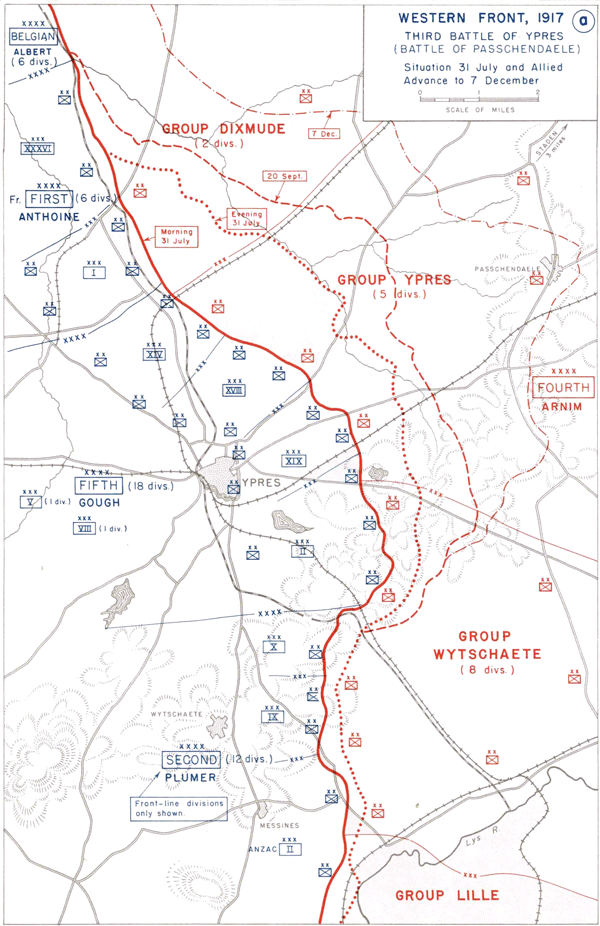
The 1st/8th Battalion was a Territorial Force Battalion, mobilised in 1914, and sent to France in May 1915, where they were part of 152nd Brigade in the 51st (Highland) Division. They had fought at Festubert in May and Givenchy in June of 1915; at the Somme in 1916; and Arras in 1917, where they had sustained heavy casualties. On 30th May 1917, they had begun the move northwards, preparatory to the build-up for the Third Battle of Ypres. For the background to the battle, see the story of William John Farrow Bates, also killed on the opening day.
Richard's service record states that he joined the Battalion "in the field" on 10th June 1917. By that date, they had reached the small village of Recques sur Hem, between Calais and St Omer, where they spent ten days resting and training. However, the 1st/8th Battalion's War Diary makes no reference to reinforcements joining on that date, though it does record that 34 other ranks had joined on 4th June at Hestrus, further south.
The Fifth Army was to attack on a front of about 7½ miles around Ypres, from south of Zillebeke to Boesinghe. The Second Army, under General Plumer, was to cooperate on the right, extending the area of attack as far south as the Lys River. On the left, the French First Army, under General Anthoine, was to prevent any counter-attack from the north. Fifth Army's front consisted of four Corps, from right to left (south to north): II, XIX, XVIII, XIV.
The 51st Highland Division transferred to XVIIIth Corps on 12th June, and was informed of their role in the forthcoming attack three days later, giving them about about six weeks to prepare in detail. They were to be positioned to the north of Ypres, about 2000 yards in front of the Yser Canal.
The Divisional History observes that:
- the starting position was poor, overlooked by the German positions, and the defences needed improvement
- the position to be taken in the attack could not be seen from the starting point
- artillery was required to cut large belts of wire which could not be seen from the ground
While the starting position was prepared by the Royal Engineers and 8th Royal Scots, an extensive training programme took place for the rest of the Division, including large scale models. All units were given a short tour in the front line to familiarise themselves with the ground - the 1st/8th took their turn between 7th-11th July. More training followed, specifically in the plan of attack, until they were moved back up to the forward area on 24th July. A and B Companies moved up to the assembly trenches on the front line on 28th July, and C and D Companies joined them on 30th July at 6.30pm. Unfortunately, Richard's service record does not include any reference to his company, so his precise role on the day of the attack is not known.
The Divisional front was about 1400 yards. The German front system they faced consisted of front, support and reserve line trenches, some 300-500 yards in depth, supported by fortified farms and concrete blockhouses. About 800 yards to the rear of the front system was a deeply wired line of trenches, supported by more fortified farms and blockhouses. Behind this second system of trenches, at a distance of 1500-2000 yards, ran the Steenbeek river, normally fordable, except after heavy rain. 1500 yards beyond the Steenbeek was another strongly-wired line, known as the Langemarck-Gheleuvelt line.
The Division's plan of attack had four stages:
- the first objective, called the "Blue" line. This included the front line system
- the second objective, called the "Black" line. This was the second system of deeply-wired trenches, with supporting fortified farms and blockhouses
- the third objective, called the "Green" line, which was the Steenbeek river
- the fourth objective - two advance posts beyond the Steenbeek, one on the right called the Mon du Rasta, and another on the left on the Military Road (see the map below), each to be occupied by one company
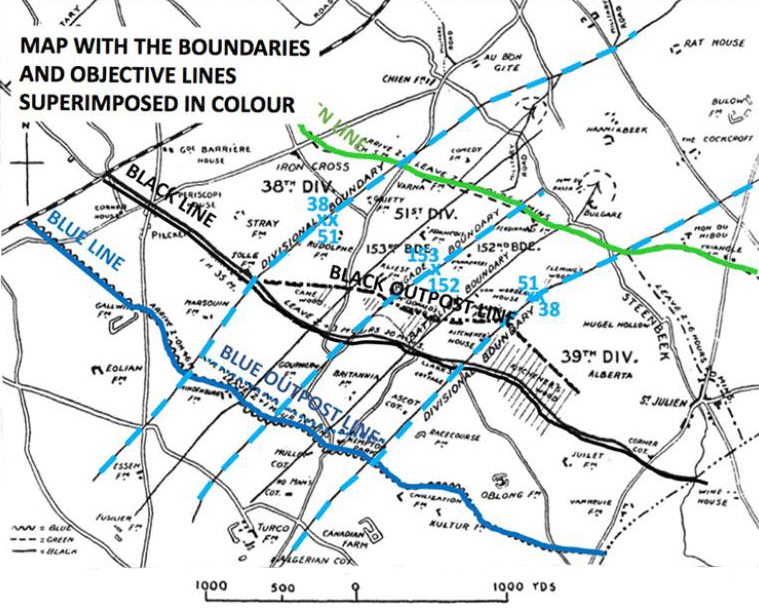
The positions of the various farms were known, but not the blockhouses; nor was it known to what extent the farm buildings had been fully incorporated into the defences. It was decided to attack all farm buildings less than 200 yards in advance of the main objectives without pausing after the capture of each objective. The farm buildings between the Blue and Black lines constituted the "Blue outpost line" and those between the Black and Green lines were the "Black outpost line".
The plan was to attack on a two-brigade front, with 152nd Brigade on the right, and 153rd Brigade on the left. Each Brigade attacked on a two-battalion front, the leading battalions taking the Blue line, and the remaining two battalions in each Brigade then passing through to take the Green line.
Though the Battalion's War Diary does not mention it, an immense fifteen-day bombardment began on 15th July all along the front. By zero-hour on 31st July, 3.50am, the trenches and farms of the Blue line had been obliterated. The Blue line was taken quickly and according to plan.
However, the advance to the Black line proved more difficult. The defences were more strongly held and the farms and blockhouses were largely intact. The Black outpost line was taken after severe fighting.
The advance to the Green line went forward while fighting on the Black outpost line was still continuing. Between 3 and 4pm, an attempted enemy counter-attack failed, and taking advantage of this, a company of the 6th Seaforth Highlanders, reinforced by two platoons from the 1st/8th Argyll & Sutherland Highlanders, crossed the Steenbeek, and were able to establish the two forward posts which were the objective for the fourth stage of the plan of attack. However, during the afternoon, heavy rain turned the river into a torrent, and the positions were at risk of becoming isolated. The forward posts were withdrawn and only the bridges held, from the south bank.
The 1st/8th Battalion attacked on the left of 152nd Brigade's front, and were responsible for taking a section of the Blue line. They attacked the three lines of the front-line system, and the supporting farms and blockhouses, in waves. The Battalion's War Diary describes the attack:
The Battalion attacked the German front line ... Three platoons of B Coy attacked in the first wave, one platoon of A Coy attacked the German second line.
The second wave, consisting of 2 platoons of A coy and 3 of D Coy passed through and captured the third German line and [a position known as] Fort Caledonia.
The third wave, consisting of 1 platoon of A Coy and 1 platoon of D Coy went through and captured and consolidated Mullers Cot and Below Farm respectively.
All objectives were reached and captured, and the 1st/6th Seaforth Highlanders passed through the Battalion to attack the further objectives.
C Coy was held in reserve at Hardy's Trench. At about 11.30 am orders were received from the Brigade to advance 2 platoons of the reserve company to Britannia Farm where they were to come under the orders of the OC 1st/6th Seaforth Highlanders. These platoons were sent to reinforce the firing line just SW of the Steenbeck river. Later, they crossed the river and occupied and consolidated the Maison du Rasta, but were ultimately withdrawn from there by order of OC 1st/6th Seaforth Highlanders.
The positions taken were held overnight, until the two attacking brigades were relieved by 154th Brigade, which had not been involved in the operation.
Death
Exactly what Richard's role was in the attack is not known, but evidently he was one of the Battalion's casualties. The War Diary records one officer and fourteen men killed; with four officers and 94 men wounded; nine men were missing. It seems that his combat experience amounted to only five days - the brief spell of four days in the trenches in preparation for the attack, and the first day of the attack itself.
He was buried in a cemetery very close to the British front line, and close to where the attack on the "Blue" line took place and (presumably) where he died. The cemetery was used from July 1917 (CWGC records show the first man buried there died on 17th July). It was named "No Man's Cot" for a building nearby (shown at the bottom centre of the map above). Most of those buried there died, with Richard, on the first day of Third Ypres. Four, including him, are from the 1st/8th Battalion Argyll & Sutherland Highlanders; many are from 51st (Highland) Division.
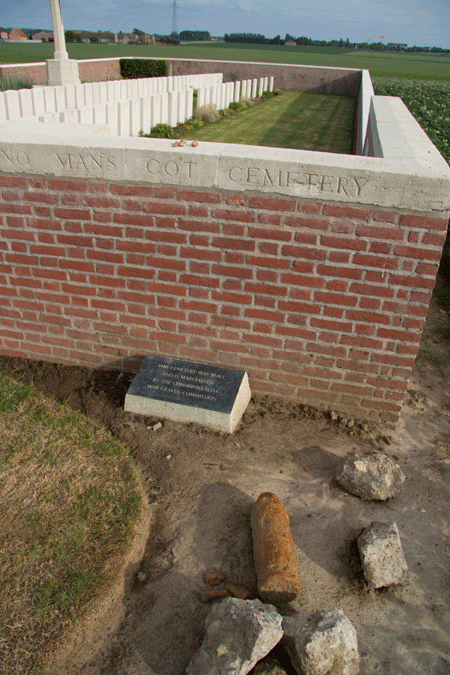
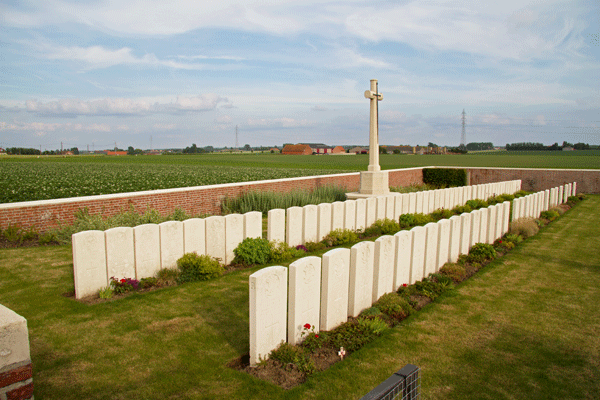

Though of course they were not identified as such, the names of the fourteen men in the Argyll & Sutherland Highlanders who had been killed in action on 31st July, including Richard's, appeared in a casualty list dated 30th August 1917, and then in the Sheffield Daily Telegraph on 1st and 3rd September 1917.
For Alice, the tragedy and the deaths had not ended. Her two youngest children, Samuel and Ernest, died six months after their father, at the family home in Studley Road. They were buried together at Darnall Cemetery on the same day, 23rd January 1918; Samuel was 22 months old, and Ernest, 8 months. A copy of the death certificate for Ernest remains within Richard's army papers (though not one for Samuel), and shows that the baby died from whooping cough and pneumonia. Shortly afterward, Alice was awarded a pension for herself and her six surviving children.
Richard's brother Lionel suffered the death of his wife Daisy in 1918. He and Alice married the following year.
Commemoration
Richard's name is included in the Sheffield City Council Official Roll of Honour, displayed at City Hall.
All three of the Carder brothers (Richard, James and Fred) are commemorated in Dartmouth on the Town War Memorial.

No doubt because of those members of the Carder family living in Paignton after the war, including his elder brother Edwin and his sister in law Elizabeth (James' wife), Richard is commemorated with James Carder on the Paignton War Memorial.
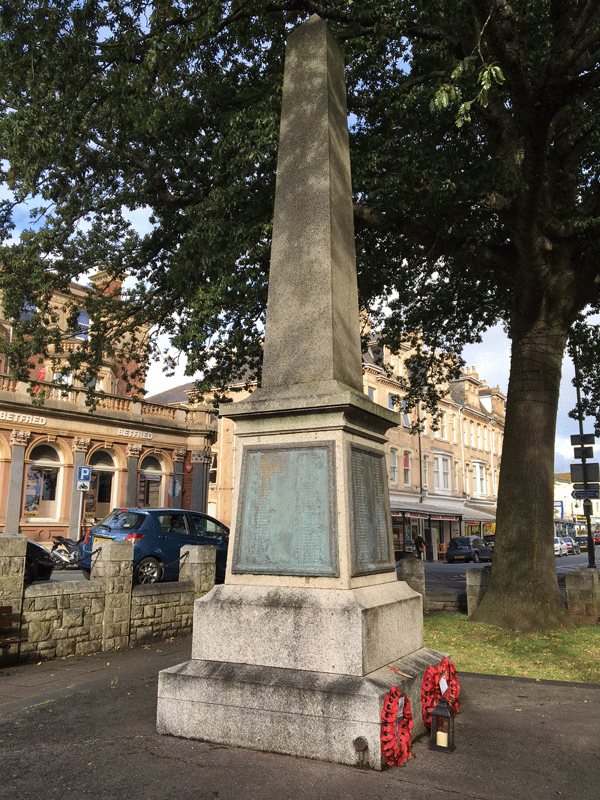
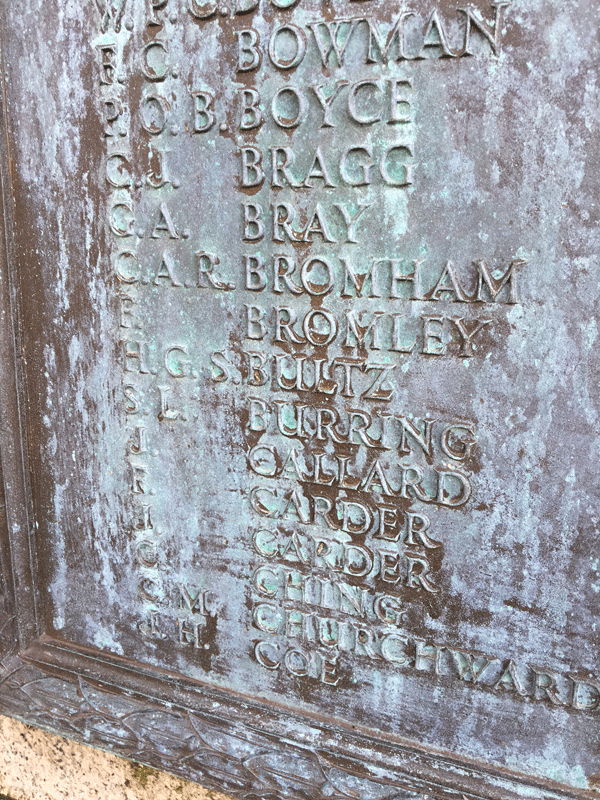
Sources
Army Service Record for Richard Goodman Carder from The National Archives, accessed through subscription websites
War Diary of 1st/8th Battalion Argyll & Sutherland Highlanders (April 1915 - March 1918) from The National Archives, available for download, fee payable, reference WO 95/2865/2
Naval Service Record of Edwin George Carder from The National Archives, available for download, fee payable, reference ADM 188/517/342136
The account of the 51st Highland Division on the first day of the Battle of Third Ypres, including the map used above, is also sourced from the 51st Highland Division Website and Online Musuem. This traces the history of the Division from its formation during the Great War through to the Second World War. See in particular the article The Third Ypres.
Sheffield City Council Official Roll of Honour
Information Held on Database
| Surname: | Carder |
| Forenames: | Richard Henry Goodman |
| Rank: | Private |
| Service Number: | S/18856 |
| Military Unit: | 1/8th Bn Argyll and Sutherland Highlanders |
| Date of Death: | 31 Jul 1917 |
| Age at Death: | 39 |
| Cause of Death: | Killed in action |
| Action Resulting in Death: | Third Battle of Ypres |
| Place of Death: | Near Ypres |
| Place of Burial: | No Man's Cot, Belgium |
| Born or Lived in Dartmouth? | Yes |
| On Dartmouth War Memorial? | Yes |
| On St Saviour's Memorials? | No |
| On St Petrox Memorials? | No |
| On Flavel Church Memorials? | No |
| In Longcross Cemetery? | No |
| In St Clement's Churchyard? | No |
| On a Private Memorial? | No |
| On Another Memorial? | Yes |
| Name of Other Memorial: | Paignton Memorial, Sheffield City Roll of Honour |















